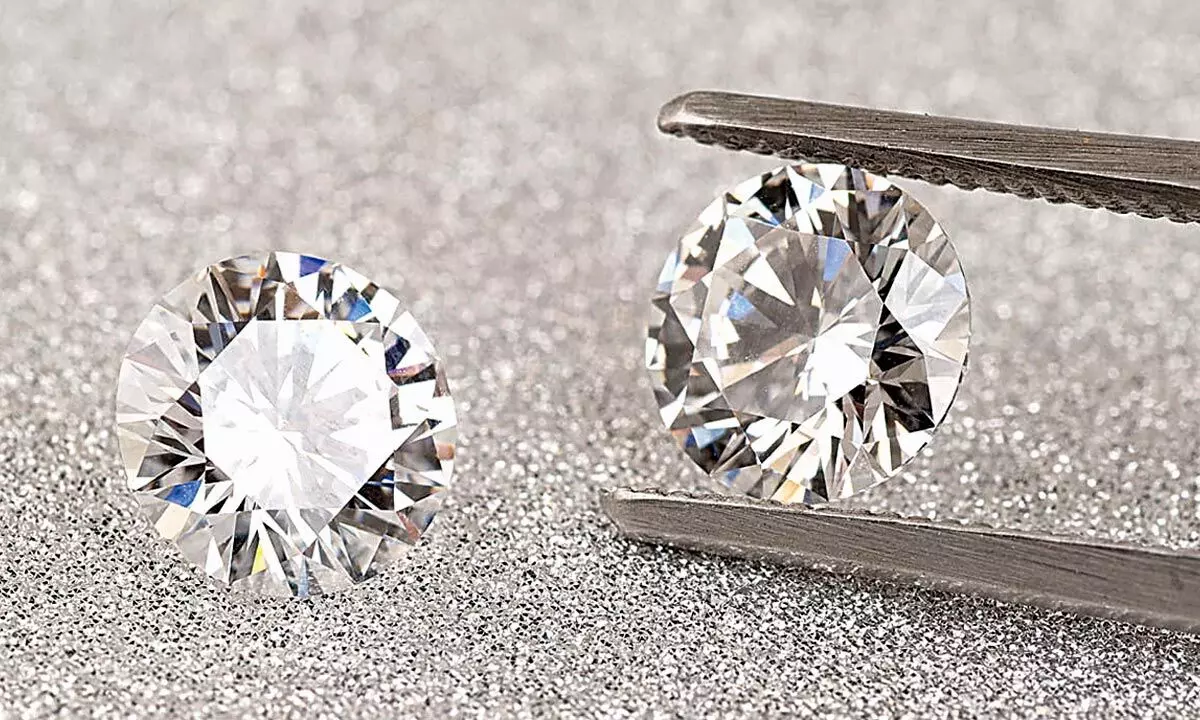Glitter of lab-grown diamonds can add sheen to India’s diamond industry
Exports of polished diamond grew 48 per cent year-on-year last fiscal while rough diamond imports were up 74 per cent
image for illustrative purpose

The increasing prices and short supply of natural diamonds has also meant a growing shift in consumer interest towards lab-grown diamonds, which resemble natural diamonds and are 50-60 per cent cheaper to boot, offering growth opportunities in a price sensitive market
India's diamond industry is likely to witness a 15-20 per cent decline in revenue in this financial year due to falling demand and rising prices of rough gemstone globally, according to a report.
Revenue of the Indian diamond industry is set to be cut 15-20 per cent to $19-20 billion this fiscal, compared with a decadal high in the last financial year, following a double blow from falling demand and rising prices of roughs across the globe, Crisil Ratings said in a report.
"While volatility in rough diamond prices is typically passed on to the polished diamond prices -- albeit with a lag due to the long operating cycle in the trade -- tepid demand has kept polished prices from fully catching up with rough prices this time around.
"This could squeeze the operating profitability of Indian diamond polishers by 75-100 basis points to 4-4.25 per cent this fiscal. Accordingly, interest coverage may weaken marginally," said Crisil Ratings Chief Ratings Officer SubodhRai.
According to the report, a surge in Covid-19 cases has led to lockdowns in several regions in China, which is one of the largest consumers of Indian polished diamonds.
Further, it noted that inflation and opening up of other avenues of discretionary spending such as travel and hospitality will dampen demand growth in the US and Europe in the near term.
As for prices, the US sanctions on Russian diamond mining company Alrosa following the invasion of Ukraine has cut supplies of rough diamonds by almost 30 per cent.The state-owned company is the largest diamond producer in the world and the supply constraint will continue amid sanctions on Russia, the report said.Also, key buyers in the US and EU have been insisting on certificates of origin and as a result, the prices of roughs have shot up almost 30 per cent since the start of this fiscal, it noted.
On the brighter side, the report said that payments from customers have been timely and this, along with reduced inventory, will control reliance on external debt.As a result, the total outside liabilities to tangible net worth ratio will remain under 1.5 times for the industry, keeping the credit risk profiles of players steady.
The report also revealed that pent-up demand and the strong festive season saw Indian diamantaires stocking up rough diamonds in the second half of last fiscal.
While exports of polished diamond grew 48 per cent year-on-year last fiscal, rough diamond imports were up 74 per cent, with almost 40 per cent of the imports being in the closing quarter.
The huge inventory build-up was corrected in the first quarter of this fiscal, following the onset of the Russia-Ukraine war at the fag-end of last fiscal and disruptions in the Chinese market because of new variants of Covid-19.
"The increasing prices and short supply of natural diamonds has also meant a growing shift in consumer interest towards lab-grown diamonds, which resemble natural diamonds and are 50-60 per cent cheaper to boot, offering growth opportunities in a price sensitive market. The market share of lab-grown diamonds is estimated to have expanded to about eight per cent presently from less than three per cent two years ago,” Rai said.
Natural diamonds are formed at great heat and pressure deep underground and since 1950s, scientists have been trying to recreate that process above ground - resulting in two techniques.
"The natural diamonds and lab-grown diamonds are so similar that once, even after a lab test there was confusion about the origin of a diamond. The diamond had to be tested twice to make sure that it was a lab-grown," he says.
Lab-grown diamonds (LGDs) so closely resemble natural diamonds that even experts have to look closely.
"No naked eye can tell the difference between natural and lab-grown diamonds. The second process is called Chemical Vapour Deposition (CVD) and involves putting the seed in a sealed chamber filled with carbon-rich gas and heating to around 800C. The gas sticks to the seed, building up a diamond atom by atom.While those techniques emerged in the late 20th Century, it's only in the last 10 years that the process has been refined so that lab-grown diamonds can be made at the right price and quality to be sold as jewellery,” he adds.
These days, a one carat diamond - a popular size and common in engagement rings - made in a lab would be around 20% cheaper than its naturally-formed equivalent.
The falling costs have attracted entrepreneurs. Experts are able to monitor the growth of the diamond, atom by atom, at the highest degree of purity.

